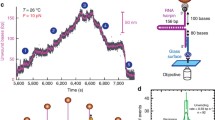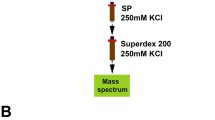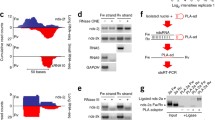Abstract
The heterogeneous nuclear ribonucleoprotein A1 (hnRNP-A1) is known as an RNA- and single-stranded DNA-binding protein involved in alternative splicing of mRNA, RNA transport and maintenance of chromosome telomere length. In this study we tested whether this protein could bind directly to double-stranded DNA (dsDNA). Using PCR amplification of target DNA-sequences from human chromosome 11q13 followed by their incubation with hnRNP-A1 and atomic force microscopy (AFM) of the DNA/protein complexes, we found that this protein bound to DNA within a 36 bp sequence. These results were confirmed by electrophoretic mobility shift assay (EMSA). This sequence was found widely dispersed throughout the genome. There is no overlap between the 36 bp sequence and known target sequences in RNA for binding hnRNP-A1.
Similar content being viewed by others
References
Dreyfuss G, Matunis MJ, Piñol-Roma S, Burd CG: hnRNP proteins and the biogenesis of mRNA. Annu Rev Biochem 62: 289–321, 1993
Merrill BM, Stone KL, Cobianchi F, Wilson SH, Williams K: Phenylalanines that are conserved among several RNA-binding proteins form part of a nucleic acid-binding pocket in the A1 heterogeneous nuclear ribonucleoprotein. J Biol Chem 263: 3307–3313, 1988
Buvoli M, Cobianchi F, Biamonti G, Riva S: Recombinant hnRNP protein A1 and its N-terminal domain show preferential affinity for oligodeoxynucleotides homologous to intron/exon acceptor sites. Nucleic Acids Res 18: 6595–6600, 1990
Casas-Finet JR, Smith JD Jr, Kumar A, Kim JG, Wilson SH, Karpel RL: Mammalian heterogeneous ribonucleoprotein A1 and its constituent domains. Nucleic acid interaction, structural stability and self-association. J Mol Biol 229: 873–889, 1993
Michael WM, Choi M, Dreyfuss G: A nuclear export signal in hnRNP A1: A signal-mediated, temperature-dependent nuclear protein export pathway. Cell 83: 415–422, 1995
Weighardt F, Biamonti G, Riva S: The roles of heterogeneous nuclear ribonucleoproteins (hnRNP) in RNA metabolism. BioEssays 18: 747–756, 1996
Pollard AJ, Sparey C, Robson SC, Krainer AR, Europe-Finner GN: Spatio-temporal expression of the trans-acting splicing factors SF2/ ASF and heterogeneous ribonuclear proteins A1/A1B in the myometrium of the pregnant human uterus: A molecular mechanism for regulating regional protein isoform expression in vivo. J Clin Endocr Metab 85: 1928–1936, 2000
Lau JS, Baumeister P, Kim E, Roy B, Hsieh T, Lai M, Lee AS: Heterogeneous nuclear ribonucleoproteins as regulators of gene expression through interactions with the human thymidine kinase promoter. J Cell Biochem 79: 395–406, 2000
Tanigawa M, Machida M, Okada TA: Sensitive and rapid method for mapping protein bound to DNA by atomic force microscopy. Biosci Biotech Biochem 61: 1751–1753, 1997
Stoyanov DI, Donev RM: Gene reorganisations and expression of cras, c-src, c-mos and c-fos oncogenes in Namalwa, Wish and C6 cells. Oncol Rep 7: 1149–1155, 2000
Shuman S: Recombination mediated by vaccinia virus DNA topoisomerase I in Escherichia coli is sequence specific. Proc Natl Acad Sci USA 88: 10104–10108, 1991
Shuman S: Novel approach to molecular cloning and polynucleotide synthesis using vaccinia DNA topoisomerase. J Biol Chem 269: 32678–32684, 1994
Tanigawa M, Okada T: Atomic force microscopy of supercoiled DNA structure on mica. Anal Chim Acta 365: 19–25, 1998
Bowen WR, Doneva TA: Artefacts in AFM studies of membranes: Correcting pore images using fast fourier transform filtering. J Membr Sci 171: 141–147, 2000
Enukashvily NI, Lobov IB, Kukalev A, Podgornaya OI: A nuclear matrix protein related to intermediate filaments proteins is a member of the complex binding alphoid DNA in vitro. Cell Biol Int 24: 483–492, 2000
Burd CG, Dreyfuss G: RNA binding specificity of hnRNP A1: Significance of hnRNP A1 high-affinity binding sites in pre-mRNA splicing. EMBO J 13: 1197–1204, 1994
Pederson T: Thinking about a nuclear matrix. J Mol Biol 277: 147–159, 1998
Tan J, Wooley JC, LeStourgeon WM: Nuclear matrix-like filaments and fibrogranular complexes form through the rearrangement of specific nuclear ribonucleoproteins. Mol Biol Cell 11: 1547–1554, 2000
Donev RM, Djondjurov LP: Tightly bound matrix DNA probably plays an important role in organisation of chromosome centromeres. Mol Biol 34: 120–126, 2000
Rights and permissions
About this article
Cite this article
Donev, R.M., Doneva, T.A., Bowen, W.R. et al. HnRNP-A1 binds directly to double-stranded DNA in vitro within a 36 bp sequence. Mol Cell Biochem 233, 181–185 (2002). https://doi.org/10.1023/A:1015504318726
Issue Date:
DOI: https://doi.org/10.1023/A:1015504318726




